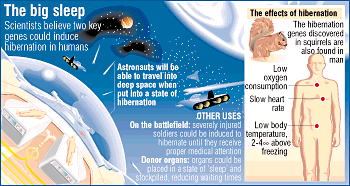Hibernation Hormone and How to Stop the Bleeding

First, this newsfeature about a hibernation hormone in chipmunks, and what we might learn from it. The paper appears in the April 7 Cell.
"One of the most curious biological phenomena in mammals is their ability to hibernate circannually, which allows them to survive unusually low body temperatures at or near freezing," said study author Takashi Ohtsu of Kanagawa Academy of Science and Technology in Japan. Scientists have attempted for decades to identify substances responsible for hibernation in the blood and organs of hibernating animals but have met with little success, the researchers said.
"Although the functions of HP remain to be clarified, the current observations lead us to propose the involvement of the protein complex in the regulation of energy metabolism and/or biological defenses during hibernation--crucial events for adapting to the severe physiological state," Ohtsu said.
In the current study, the researchers first demonstrated that hibernation in chipmunks is strictly controlled by an individual's internal circannual rhythm even under conditions of constant cold. In 20 hibernators examined throughout their lives, concentrations of HPc in the blood started to decrease prior to hibernation and remained low throughout the inactive state. Hibernation ended after blood HPc levels rose.
Further study revealed an inverse relationship between HPc levels in the blood and brain. While HPc levels dipped in blood, the putative hormone rose dramatically in cerebral spinal fluid, they reported. Likewise, HPc levels decreased abruptly in spinal fluid when hibernation terminated.
The researchers also found that blocking the activity of one of the HP complex proteins in the brain with antibody greatly decreased the hibernation time during which the chipmunks maintained a lowered body temperature, suggesting its critical role in the brain's capacity for dormancy. Story source.
Second, we learn about carbon monoxide's (CO) role in traumatic bleeding, and how blockers of CO might be useful in the trauma setting.
The study of CO in the tissues -- including its role in diabetes, cardiac dysfunction, hypertension and asthma -- has become the subject of increasing interest for researchers. However, this is the first time scientists are looking at its role in soft tissue trauma, said lead researcher Mary E. McCarty, who presented the study at an APS session at Experimental Biology 2006.
Small amounts of CO exist in the tissues, the result of the breakdown of a blood component known as heme. Carbon monoxide helps control blood pressure by dilating blood vessels, McCarty said. Her team reasoned that blocking the dilating action of CO would cause injured blood vessels to constrict, limiting bleeding and maintaining adequate blood pressure.
The research is still a long way from use in humans. But if successful, this new line of inquiry could eventually help stanch massive bleeding in instances of soft tissue trauma and help reduce the need for blood transfusions of patients facing lengthy surgery, among other uses. Source.
Coincidentally, CO is one of the triggers for hibernation, in research studies, along with H2S and total darkness. The search for suspended animation--for purposes of reducing the risks of a difficult surgery, or to stabilise a patient until a definitive procedure can be carried out--is important. Quite a few other uses for human hibernation are conceivable. Present methods of freezing a person--sometimes only the head--are not generally considered efficacious.
Here is a previous Al Fin posting on hibernation.
Labels: human hibernation

0 Comments:
Post a Comment
“During times of universal deceit, telling the truth becomes a revolutionary act” _George Orwell
<< Home